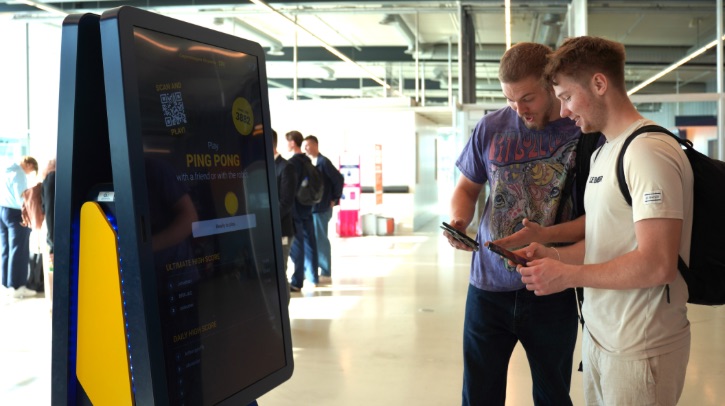Copenhagen Airport in Denmark has reported a significant rise in passenger satisfaction and engagement thanks to its new advanced infotainment robot, developed by Autonomous Units, and now plans to add two more robots in the coming months.
Gamified autonomous robots
Driving in the airport’s Pier F for several months, the current robot offers a blend of commercial, entertainment and information for passengers. According to the airport, satisfaction with the entertainment value at the airport is 15% higher among passengers who have interacted with the robot, and a full 90% of passersby notice it.
As the robot moves through the gate area, it captures passengers’ attention with an interactive Ping Pong game displayed on its screen. By scanning a QR code, passengers can use their phones to play the game – 174 passengers have been playing the game on average per day, for an average of 53 seconds each.
The robot can move at a speed of 1km/h, weighs 130kg and is 2m tall, and can operate for 8-9 hours after charging for three hours. It is also capable of speech, so it can make announcements about delays or gate changes.
The airport states that the robotic solution was noticed by 90% of passing passengers, had 8-10 times more interaction than a stationary screen, and contributed to a 22% higher retail revenue.
Robot revenue opportunities
The robot also offers several commercial features that create new revenue opportunities for the airport, such as branding and advertising integration and customized interaction options based on passenger demographics, location or destination.
At the end of the Ping Pong game, the robot can redirect passengers to a website or app, or offer a survey or a discount voucher for airport shops, which keeps engagement high even after the game. And in the future, the airport is also considering expanding the experience by integrating other types of games and entertainment, such as AI-based photo features, enabling passengers to take photos and interact with the robot in creative ways.
Flemming Thinggaard, CEO of Autonomous Units, said, “We have filled a gap in the market by creating local interaction with the self-driving robot. We call it a local sales funnel, as 90% of passengers passing by notice it – marking the beginning of a new customer journey.”
“We’ve seen an incredible impact on passenger satisfaction, and the robot has proven to be a game-changer at CPH. Passengers play an average of 175 games daily in Pier F, with each game lasting an average of 53 seconds. These small experiences make a big difference in our passengers’ travel experience,” said Jonathan Vincentz, project manager at Copenhagen Airport.
“We see great potential in using the robot to create even more value. We can integrate commercial logos into the games, display advertisements before and after each game, and on the user’s phone, we can offer everything from a voucher to a link to a relevant website or a brief survey after the game. This provides us with a unique opportunity to engage passengers.”
In related news, a self-driving food and beverage robot, named the Jeeves service robot, was recently introduced at Munich Airport in Germany. Click here to read the full story.

